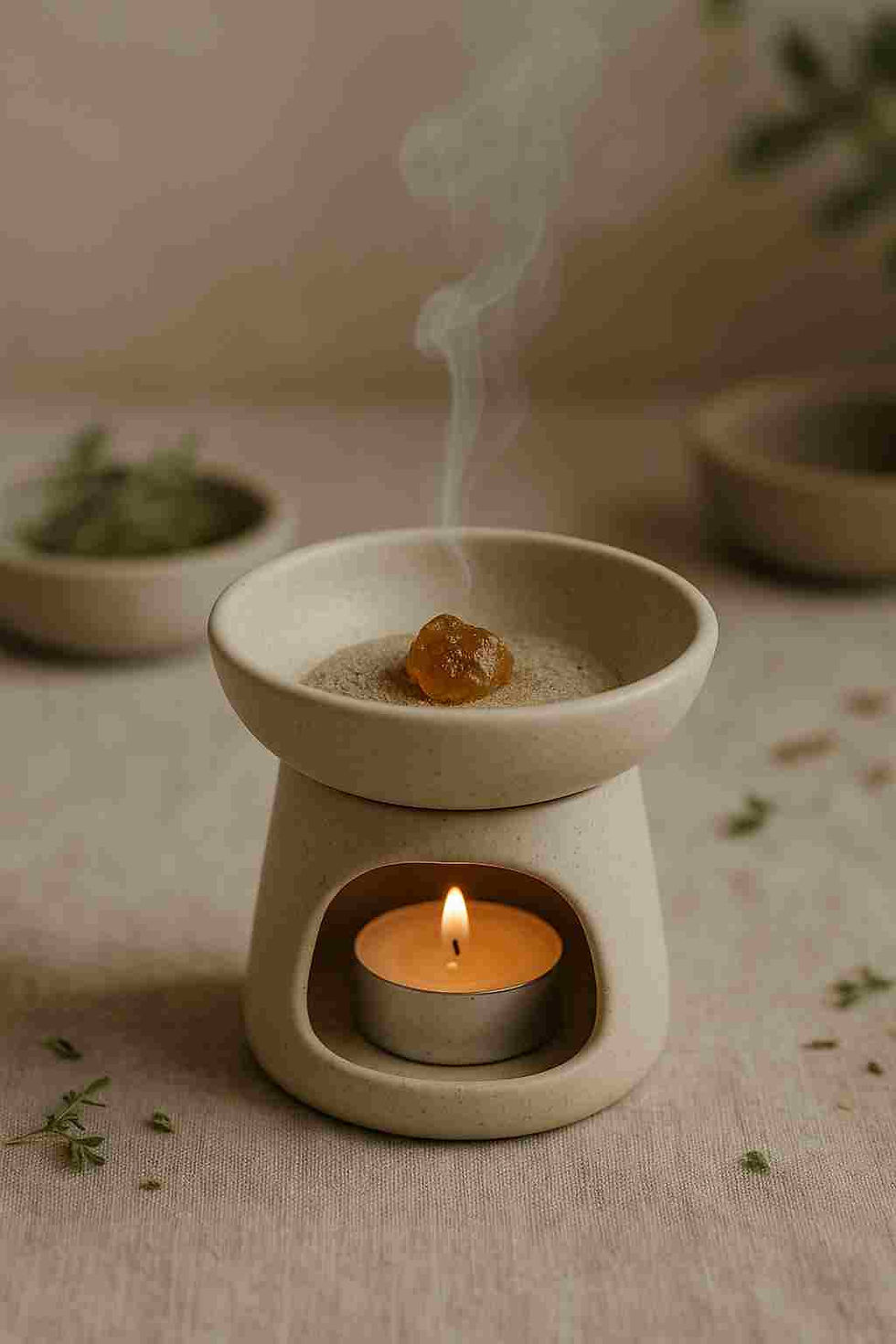Winter Incense Blends: Best Materials for Warming, Resin-Rich Aromas
- Astrid van Essen
- Oct 15
- 4 min read
Updated: Oct 31
When the air turns crisp and the days grow shorter, I always find myself drawn to deeper, richer scents. There’s something comforting about the slow curl of incense smoke filling a room on a winter evening. It brings warmth, calm, and a quiet sense of ritual.
Whether you prefer burning resins, herbal mixtures, or handmade cones, the materials you use make all the difference. Here’s what I’ve learned about crafting resin-rich incense blends that suit the colder season perfectly.

Why Winter Incense Feels So Comforting
Scent has a powerful effect on our mood. In winter, when everything feels slower and the air indoors can become dry and stale, incense creates an atmosphere that’s both grounding and uplifting.
Smoky, resinous notes, such as myrrh, cedar, and cinnamon, add warmth and texture to a space. Lighting incense in the evening feels like a small act of care — one that invites stillness and reflection at the end of the day.
Essential Materials for Warming, Resin-Rich Blends
1. Resins – The Heart of Winter Incense
Resins form the base of many traditional incense recipes. These natural substances are collected from tree sap and harden into glossy, aromatic pieces that release deep, complex scents when heated.
Best winter resins:
Frankincense – citrusy, bright and slightly spicy, perfect for clearing the air.
Myrrh – dark, earthy and resinous, adding grounding depth.
Benzoin – sweet and vanilla-like, softening stronger aromas.
Copal – warm and golden, a cleaner alternative to charcoal-based blends.
I often combine myrrh with benzoin for a balanced scent — sweet yet smoky, soothing without being too heavy.
2. Woods – The Base That Grounds the Blend
Wood powders lend structure to incense blends, allowing them to burn slowly and evenly. They also provide a natural, steady fragrance that anchors lighter notes.
Recommended woods:
Sandalwood – smooth, warm and creamy. A perfect base for any winter mix.
Cedarwood – crisp and slightly smoky with a forest-like freshness.
Agarwood (Oud) – intensely rich and aromatic, ideal for luxurious blends.
A simple combination of sandalwood and frankincense is timeless, creating a soft, lingering scent that feels both calming and refined.
3. Herbs and Spices – The Spark of Warmth
Herbs and spices bring brightness to winter incense. Used in small amounts, they add subtle warmth and complexity.
Favourites for winter:
Cinnamon – spicy, sweet and instantly comforting.
Clove – sharp and woody, complements resins beautifully.
Star Anise – adds a soft, sweet liquorice note.
Dried Orange Peel – brings a hint of citrus to balance heavier resins.
These materials pair especially well with festive blends. Try adding a touch of ground clove to your resin mix for a subtle holiday scent.
4. Binders – For a Smooth, Even Burn
If you’re making cones or sticks, a binder is essential. It holds the ingredients together and ensures a consistent burn.
Natural options include:
Makko powder (from the Machilus tree) – burns evenly and has almost no scent.
Tragacanth, also known as Arabic gum, creates stickier pastes that work well for shaped incense.
Avoid synthetic binders if you prefer a clean, natural aroma. Makko powder remains my go-to for its reliability and subtle finish.

Example Blend: Frankincense & Cinnamon Glow
This warming blend is simple to make and perfect for cosy evenings.
You’ll need:
2 parts frankincense resin
1 part sandalwood powder
½ part benzoin
A pinch of cinnamon powder
Optional: a few drops of sweet orange essential oil
Grind the resins into fine pieces and mix with the powders. Add a little water and makko powder to form a soft dough if you’d like to shape cones or sticks.
Otherwise, use the mixture loosely in a heatproof burner. The result is a rich, golden scent with hints of citrus and spice — warm, balanced, and beautifully seasonal.
How to Burn Resin-Rich Incense Safely
Resin incense burns at higher temperatures than sticks, so it’s important to use a suitable burner.
Select a heatproof ceramic or concrete bowl.
Line it with sand or foil to protect the surface.
Place a small piece of charcoal or use a gentle heat source such as an electric incense burner.
Always start with a small amount to test how it burns.
Keep the area ventilated and never leave burning incense unattended.
If you’ve read my experiment with using a hotplate for resins, you’ll know how beautifully slow heating can release fragrance without smoke. It’s a clean, modern way to enjoy natural materials.
Final Thoughts
Winter incense blends are all about depth and warmth. Resins provide body and longevity, woods bring grounding notes, and spices add vibrancy. Once you start experimenting, you’ll find that every material behaves differently — some melt, others smoulder — and that discovery becomes part of the pleasure. Creating your own blends is not just about scent, but about slowing down and shaping a sensory ritual that makes winter feel calm and inviting.
You may also like
Winter Incense Blends FAQ
1. What are the best resins for winter incense?
Frankincense, myrrh and benzoin work beautifully. They create rich, grounding aromas that feel perfect for the season.
2. Can I mix herbs and resins together?
Yes. Combining resins with herbs like rosemary or spices such as cinnamon creates complex, layered blends.
3. What binder should I use for incense cones?
Makko powder is the most reliable natural choice. It burns cleanly and doesn’t interfere with the scent.
4. How do I store homemade incense blends?
Store them in airtight glass jars, keeping them away from direct sunlight. Allow freshly made cones to dry completely before storing.
5. What’s the difference between resin and stick incense?
Resin incense is burned loose on charcoal or a heat source, while stick and cone incense use powders and binders to hold their shape.



Comments